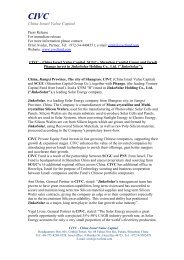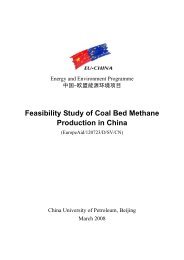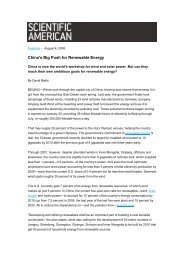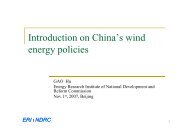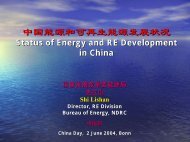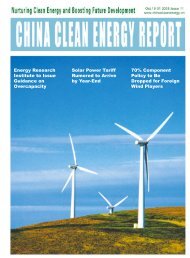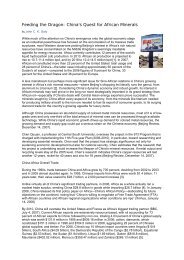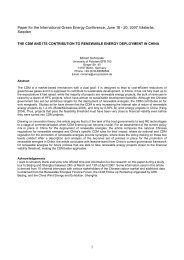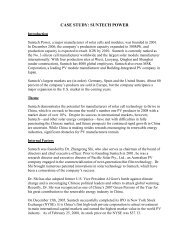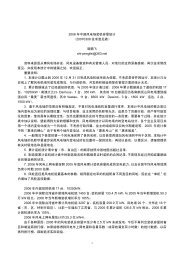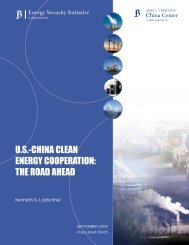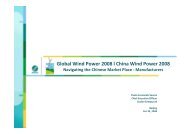LDK Solar Co., Ltd. - Asia Europe Clean Energy (Solar) Advisory Co ...
LDK Solar Co., Ltd. - Asia Europe Clean Energy (Solar) Advisory Co ...
LDK Solar Co., Ltd. - Asia Europe Clean Energy (Solar) Advisory Co ...
You also want an ePaper? Increase the reach of your titles
YUMPU automatically turns print PDFs into web optimized ePapers that Google loves.
Reduction or elimination of government subsidies and economic incentives for the solar power industry<br />
could cause demand for our products to decline, thus adversely affecting our business prospects and<br />
results of operations.<br />
Growth of the solar power market, particularly for on-grid applications, depends largely on the availability<br />
and size of government subsidies and economic incentives. At present, the cost of solar power substantially<br />
exceeds the cost of conventional power provided by electric utility grids in many locations around the world.<br />
Various governments have used different policy initiatives to encourage or accelerate the development and<br />
adoption of solar power and other renewable energy sources. Renewable energy policies are in place in the<br />
<strong>Europe</strong>an Union, most notably Germany and Spain, certain countries in <strong>Asia</strong>, including China, Japan and<br />
South Korea, and many of the states in Australia and the United States. Examples of government-sponsored<br />
financial incentives include capital cost rebates, feed-in tariffs, tax credits, net metering and other incentives to<br />
end-users, distributors, system integrators and manufacturers of solar power products to promote the use of<br />
solar power in both on-grid and off-grid applications and to reduce dependency on other forms of energy.<br />
Governments may decide to reduce or eliminate these economic incentives for political, financial or other<br />
reasons. Reductions in, or eliminations of, government subsidies and economic incentives before the solar<br />
power industry reaches a sufficient scale to be cost-effective in a non-subsidized marketplace could reduce<br />
demand for our products and adversely affect our business prospects and results of operations.<br />
We operate in a competitive market against players with greater resources and more advanced<br />
technologies and we may not be able to compete successfully.<br />
The multicrystalline solar wafer manufacturing market is competitive. Our competitors include international<br />
players such as affiliates of BP plc, or BP <strong>Solar</strong>, Deutsche <strong>Solar</strong> AG, or Deutsche <strong>Solar</strong>, Evergreen<br />
<strong>Solar</strong> Inc., or Evergreen <strong>Solar</strong>, Green <strong>Energy</strong> Technology, Inc., or Green <strong>Energy</strong>, JFE Steel <strong>Co</strong>rporation, or<br />
JFE, Kyocera <strong>Co</strong>rporation, or Kyocera, M.SETEK <strong>Co</strong>. <strong>Ltd</strong>., or M.SETEK, PV Crystalox <strong>Solar</strong> AG, or PV<br />
Crystalox, and Renewable <strong>Energy</strong> <strong>Co</strong>rporation ASA, or REC, and MEMC Electronic Materials, Inc., or<br />
MEMC, which has announced plans to manufacture multicrystalline solar wafers. Our competitors also<br />
include companies located in China such as Jiangsu Shunda PV-Tech <strong>Co</strong>., <strong>Ltd</strong>., or Shunda, Jinggong P-D<br />
Shaoxing <strong>Solar</strong> <strong>Energy</strong> Technology <strong>Co</strong>., <strong>Ltd</strong>., or Jinggong P-D, and Tianwei Yingli New <strong>Energy</strong> Resources<br />
<strong>Co</strong>., <strong>Ltd</strong>., or Tianwei Yingli. Many of our current and potential competitors have a longer operating history,<br />
better name recognition, greater resources, larger customer base, better access to polysilicon feedstock and<br />
greater economies of scale than we do. In addition, most of our competitors are integrated players in the solar<br />
industry that also engage in the production of virgin polysilicon, photovoltaic cells and/or modules. Their<br />
business models may give them competitive advantages as these integrated players place less reliance on the<br />
upstream suppliers and/or downstream customers in the value chain. We currently have no plans to expand<br />
into the production of photovoltaic cells or modules, and we have entered into non-competition agreements<br />
with some of our customers, pursuant to which we have agreed not to engage in the production of solar cells or<br />
modules based on current wafer technology for the next 10 years. Furthermore, due to the perceived growth in<br />
demand for multicrystalline wafers, we expect an increase in the number of competitors over the next few<br />
years. The key barriers to entry into our industry at present consist of access to supplies of solar-grade<br />
polysilicon, availability of financing and availability of various production equipment, such as ingot-producing<br />
DSS furnaces and wafering equipment. If these barriers disappear or become more easily surmountable, new<br />
competitors may successfully enter our industry, resulting in loss of our market share and increased price<br />
competition.<br />
Within the crystalline wafer industry, we also compete with monocrystalline wafer manufacturers.<br />
According to <strong>Solar</strong>buzz, monocrystalline wafers in 2006 represented approximately 42% of the global<br />
photovoltaic cell production while multicrystalline wafers constituted approximately 49%. Certain monocrystalline<br />
wafer manufacturers have begun or intend to manufacture multicrystalline wafers, and they currently<br />
supply multicrystalline wafers to multicrystalline photovoltaic cell manufacturers, including some of our<br />
customers. Manufacturers of monocrystalline wafers that compete with us include Ersol <strong>Solar</strong> <strong>Energy</strong> AG, or<br />
Ersol, M.SETEK, ReneSola <strong>Ltd</strong>., or Renesola, Sumitomo Mitsubishi Silicon <strong>Co</strong>rporation, or SUMCO, and<br />
Sino-American Silicon Products Inc., or Sino-American Silicon, and Trina <strong>Solar</strong> Limited.<br />
12



